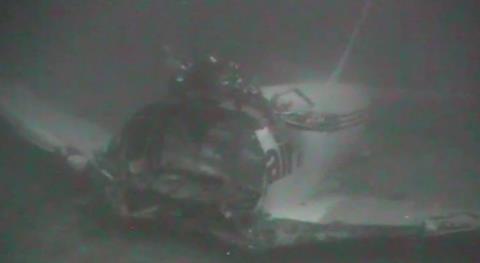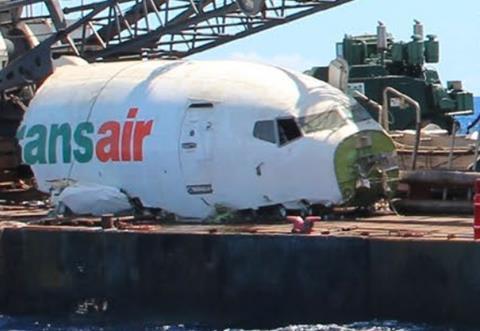US investigators believe pilots of a Transair Boeing 737-200 freighter which ditched in the ocean off Honolulu did not verify which engine had failed shortly after take-off, despite initially correctly identifying the damaged powerplant.
When the first officer, who was flying the twinjet, reduced thrust to decelerate, this obscured obvious differences between the two engines’ indications on the instrument panel – making the failed engine more difficult to distinguish.
Although the first officer of the twinjet had correctly determined that the right-hand engine had suffered a problem – just after take-off on 2 July 2021 – his subsequent workload “left few opportunities for him to commit that information to memory”, says the National Transportation Safety Board.
The first officer levelled the aircraft at 2,000ft and reduced thrust on both engines to near flight-idle, slowing to 210kt – consistent with the carrier’s simulator procedures for single-engine failure.
But this eliminated the distinctive adverse yaw to the right, initially felt by the crew, and also left the cockpit engine indications “ambiguous” because both were generating low thrust, says the inquiry. The 737-200, built in 1975, had old analogue cockpit displays.
Although thrust was low on both engines, the first officer might erroneously have thought the left-hand was affected because its pressure ratio was lower than that for the right-hand engine.
There was “no longer a clear sign” which engine had failed and the pilots had “forgotten” their initial determination that the right-hand engine had lost power, the inquiry says.
“Critical thinking was required for the crew to devise diagnostic steps to confirm the affected engine,” it adds. “However, each pilot’s thinking was degraded by high workload and stress.”

Some 3min 20s after the first sign of a problem the captain took control from the first officer and asked which engine had failed. The first officer remarked – in contrast to his original assessment – that the left engine was “gone” and that the right engine was available.
Crucially the captain accepted the first officer’s conclusion without taking any action to verify it, such as advancing the thrust levers to see which engine spooled up.
“If the captain had thought to test the thrust on the left engine by advancing the left thrust lever, the flight crew would likely have noticed an increase in left engine thrust, a yaw to the right, and engine sounds indicating that the left engine was capable of producing normal power,” says the inquiry.
“The captain could also have simultaneously advanced both thrust levers and observed the left engine producing more thrust.”

None of these potential diagnostic steps was included in the carrier’s engine-failure checklist, which – owing to the substantial workload – the pilots did not begin reading until more than 4min into the emergency.
Starting the checklist earlier, the inquiry says, might have enabled the crew either to recall their correct determination of the failed engine, or take advantage of indications including the yaw or obvious differences in cockpit engine parameters.
“The checklist did not consider the possibility that a flight crew would need to delay checklist execution until after completing steps in an operator’s single-engine departure procedure – such as levelling off at a low altitude and reducing thrust on both engines,” it states.
Misidentification of the failed engine meant the crew attempted to fly using the damaged powerplant – a situation which led them to believe that both engines had problems. With insufficient thrust, the 737 lost height and ditched in the Pacific Ocean. The aircraft broke up and sank, but both pilots survived.
Examination of the right-hand Pratt & Whitney JT8D engine revealed that two high-pressure turbine blades had suffered stress fracture, owing to corrosion of blade-lightening holes. The blades’ fracturing caused secondary damage to the low-pressure turbine, causing the loss of thrust in the powerplant as the aircraft climbed out of Honolulu.


























